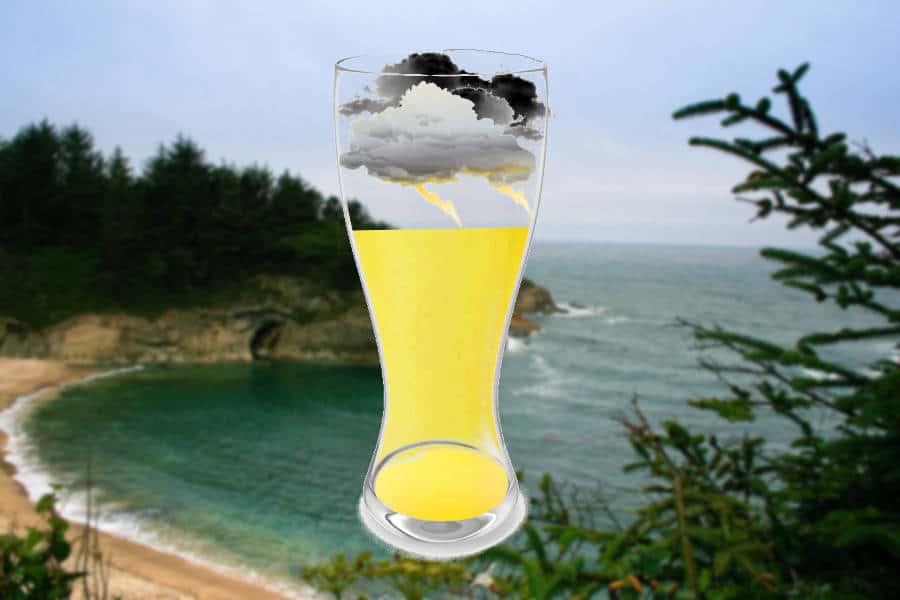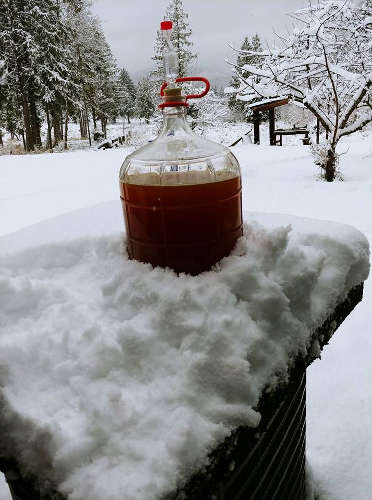When it comes to beer, just like a long weekend break, there is nothing worse than when it is cloudy. Although there may not be anything wrong with the beer itself, it just doesn’t look the way you wanted. So, as a homebrewer what steps can you take to clear your beer right up?
The first step is to get to the bottom of why beer appears to be cloudy, especially when it has been brewed at home. Each cause of opaque beer requires a slightly different approach.
So, why is your beer cloudy and what can you do to fix it?
The most common cause of cloudy or hazy beer is yeast, proteins &/or polyphenols suspended in the beer. The best solution is to cold crash your wort after boiling it to encourage most substances to sink to the bottom as ‘trub’. Other causes include starches, low-flocculating yeast or an infection.
The first thing to do is to check your brewing notes and to see where you may have gone wrong. Also, check your ingredients.
If you haven’t brewed a beer which actually was intended to have a hazy finish (wheat beers and some IPAs) then you can start going through this helpful article.
Below I have organized every possible cause of cloudy beer and given you a sure-fire way of fixing it. Be aware that in some cases this may mean a fix for the next time you brew the beer, so read on to learn how to clear up your cloudy brew.
Is cloudy homebrew OK to drink?


Absolutely yes! Even if this wasn’t the plan to start with, there is nothing wrong with drinking beer which is cloudy. In fact, with most beers, there is very little difference between a clear and cloudy version. It’s more perception and personal preference, so have a sip and see if you want another.
The usual suspect of cloudy beer
What makes beer cloudy or hazy, for the most part, occur naturally in the ingredients you use to brew it. The most common culprits of a cloudy beer are protein, polyphenols, and yeast.
Protein
Protein is present in many grains used for brewing as well as several popular adjuncts such as corn, rice, and refined sugar. Along with polyphenols, proteins can lead to what is known as a permanent haze if not successfully tackled in the brewing process.
Polyphenols
Polyphenols also occur naturally in beer brewing ingredients such as grains and hops. However, although we want these flavor giving compounds in the beer, too much is definitely a bad thing. Polyphenols can lead to oxidation of the beer and adversely affect its taste and aroma.
Yeast
Yeast is a brewer’s best friend, as long as it behaves itself. A leading cause of hazy/cloudy beer is suspended yeast in liquid. This is especially true of low-flocculating yeast.
This means that the yeast isn’t clumping together towards the end of the fermentation process and sinking to the bottom of the fermenter. Although drinking floating yeast won’t harm you, it will harm the appearance of your beer.
Tip #1: How to fix your already cloudy beer
If you have got as far a bottling or kegging your beer and it is coming out cloudy, what are your options?
Well, firstly, you can just accept the beer as it is and drink it. I’ll bet you that it tastes fine (unless there is a buttery or tart taste to it, in which case check out Bacterial infection below) and that the only thing that is ruined is those Instagram photos.
However, even at this late stage, there is something which can be done. By storing your beer at a lower temperature than you currently have it stored at, you can encourage any impurities in the beer to sink to the bottom. This is exactly the same principle as the cold crash, which I’ll go over later in this article.
Reduce the temperature of your beer to around 32°F (0°C) for a couple of hours (it won’t freeze due to the alcohol present in it) then bring it slowly back up to drinking temperature in a refrigerator. This should clear out most of the haziness even in bottled beer.
You can do the same for a keg, but it may require the use of a Keezer or Kegerator which some newer brewers may not have.
Tip #2: Using temperature to improve beer clarity
Cold crashing and the cold break

Brewers all over the world successfully use cold temperatures to improve the clarity of their beer. This process is known as cold crashing and it causes what is known as the ‘cold break’
Cold crashing means reducing the temperature of the newly boiled wort to a temperature just above freezing to encourage yeast and other material to flocculate. The beer is then ready being primed with yeast before starting the bottle conditioning process.
As liquid retains heat for much longer than, say, a solid, if you were to just let your beer cool naturally it would take quite a while. Also, as you may have killed or much of the yeast present in the beer, it’ll take longer for secondary fermentation to take place.
The reason why most brewers don’t wait for nature to take its course is that this can lead to a less dramatic change in the beer and can invite in the risk of bacterial infection. So, it’s recommended to speed up the process as best you can.
If you don’t have any other cooling equipment, then you can stick your carboy (or whatever vessel you want to cold crash your beer in) into a bath of ice or into a refrigerator. Although this will still take time to cool the liquid it will induce a cold break to some degree.
A cold break doesn’t mean going outside in winter for a smoke, no it means when we separate proteins, Polyphenols and carbohydrates from the wort by rapidly chilling it. These substances will cause the wort to look like a strange soup.
Some brewers will then try to remove the cold break debris, but it is generally a good idea to allow it to naturally sink and then leave an inch or two of liquid at the bottom of your fermenter when you bottle or keg it after fermentation. Studies have shown that total removal of the cold break can lead to slower and less effective fermentation.
In terms of forcing a more effective cold break, if you don’t have a spare refrigerator that’s big enough to accommodate your fermenter, then consider the following method.
Wrap your fermenter in wet towels and place it in a large ice bucket or, even better, an ice cooler. Place ice packs around the fermenter and keep changing them every 24-72 hours. This will be almost as effective as a refrigerator and will bring about a cold break.
Hot Break
In addition to a cold break, a good hot break at the beginning part of a boil will also reduce the haziness of your beer. It’s essential that you watch your wort vigilantly as it boils and makes sure that you don’t have a boil-over.
Although there is some debate over this, I find that by not removing the eggy substance that a hot break forms my beer turns out better. Rather, allow this material to sink back down into the beer. Just as a cold break does, a hot break affects proteins and this is a natural and desirable process.
Tip #3: Fining your beer
An additional method to remove the cloudiness from beer is to add substances to it know as ‘finings’. These are compounds that use either positive or negative charge (depending on temperature) to attract impurities in beer to them and then to sink to the bottom of the liquid.
The most common in beer brewing are Isinglass, gelatin, Irish Moss, Polyclar AT, and Silica Gel.
Be aware that if you are catering to vegetarians and vegans alike, some of these products will not be suitable. Check out my article on what beer you can serve to vegans here.
By adding a fining substance to your beer either at the end of your boil or 4-5 days before you plan to bottle it, you can force those impurities to fall to the bottom of your kettle or carboy.
Personally, I recommend using Irish Moss, or something like Whirlfloc tablets, as this is a more natural way to clear your beer and you can be sure that it’s suitable for most diets.
Buy your brewing ingredients from homebrewing.org and get them delivered to your door!
Tip #4: Spotting Bacterial infection
Another source of a hazy beer and a very annoying source at that is a bacterial invasion. Every brewer whether new or old is at risk of this every time that they brew. There is only so much you can do to prevent bacteria from entering your beer.
You’ll know that you have an infected beer when you taste excessive butteriness or a very tart tang.
This indicates the presence of diacetyl (butter taste) formed by Pediococcus damnsosus and probably the presence of Lactobacillus which produces several off-flavors and aromas but most commonly gives off that very tart aftertaste.
If this is the case for you now and your beer is truly infected, there really isn’t anything you can do to change it now. Nevertheless, it doesn’t mean the beer is a total write-off.
Apart from drinking it, you can use infected or stale beer for a number of things. In fact, I wrote an article which gives you 26 useful ways to use unwanted beer.
For next time it’s really essential that you take an obsessive approach to cleaning and sanitizing your brewing equipment. Anything that comes into contact with your wort or beer needs to be thoroughly cleaned and sanitized even if you place it down for just a moment.
You may also want to consider investing in a wort chilling system (link to my recommended gear page) as cooling wort is especially susceptible to bacteria at this stage.
Tip #5: Is there starch in your beer?
If you brewing an all-grain recipe, and to a lesser extent steeping an extract brew, then you may experience a hazy beer due to starch.
This happens when the mashing process wasn’t carried out consistently at the correct temperature or long enough for a particular malt. This can cause some starches to remain unconverted (and fairly useless) in your wort.
The solution is to diligently research the exact recommended temperature for mashing that particular malt and to keep an eagle-eye on your stopwatch.
If you find at the end of the mash that you have an excessively cloudy beer, you can extend your mashing phase a little longer to try and compensate for it.
Tip #6: Choosing the right yeast
Another issue, especially affecting brewers after fermentation, is suspended yeast in their beer. Sometimes this is the brewer’s fault as they were too eager to rack their beer and so didn’t allow the yeast to finish the job of fermenting. However, cloudy beer can also be caused by the choice of yeast used.
As I have mentioned before, the level of flocculation a beer possesses determines how well it groups and then sinks after reaching its fermentation efficiency.
This is something which we do want to happen but not until the right time. A low-flocculating beer will likely stay suspended in beer for longer causing that hazy effect famous in some beer varieties.
As a general rule, most yeast strains used in lager have medium-flocculation properties, those found in English Ale have high- flocculation properties and Hefeweizen has low-flocculation levels.
All ‘wild’ yeast strains generally also have poor flocculation properties. When sourcing your yeast from local brew shops or online, the yeast packaging will normally display this information clearly. If not, don’t be afraid to seek out advice from the sales staff. (shop for your brewing ingredients online at homebrewing.org).
Tip #7: Knowing when Beer should be hazy
One mistake, although rare, is when a new brewer actually brews a beer perfectly and it comes out cloudy just as it was intended to. This can be alarming to the brewer but only because they didn’t really understand the beer they were brewing.
I have heard of this with people who have brewed from a starter kit given to them for a birthday and have only just gotten into the hobby. So, here a couple of famously cloudy beers.
Hefeweizen
Hefeweizen is literally ‘yeast wheat’ in German and is famous for its yellowy cloudy appearance and bananary, clovy aroma. These beers are made with yeast which has a low- flocculation and thus they remain present in the beer after fermentation instead of falling to the bottom of the fermenter.
New England IPA (NEIPA)
In the last few years this beer variety, although much older, has taken the craft beer (buy beer from local breweries) and homebrewing world by storm. They are thick and pulpy as well as being hoppy and hazy. In this case, the beer gets its haziness from not undergoing the same type of filtering that some other beers, especially commercial brands, undergo. (buy beer from local breweries)
Related questions
Can cloudy beer make you sick?
There is nothing harmful in cloudy beer as all the causes of it are quite natural. Even if the beer is infected by bacteria this isn’t likely to make you ill, but it may be unpleasant to drink and if you have a sensitive stomach you may vomit due to the smell.
However, the beer is entirely safe to drink even when excessively cloudy. Please read my article here for more details.
Is it Ok to drink yeast in beer?
Yes, yeast is perfectly safe to drink and if you have ever had a German Wheat beer then you have already consumed yeast. This micro-organism is quite natural and is classified as fungi, so it’s almost like drinking a mushroom (which actually sounds a bit wrong).
Should ale be cloudy?
Some ales are indeed cloudy but it really depends on each breweries’ methods and the particular taste of the clientele. John Smith’s Extra Smooth is a fairly cloudy ale, for example, and is brewed for that finish.
Traditionally, English ales were not served when cloudy as this was a sign that the barrel conditioning had not successfully completed. However, this isn’t an indication that the beer was bad as is still though today. It just indicated that the beer needed time to settle after its transportation.
Should you filter beer before bottling?
As a homebrewer, filtering your beer before bottling it would be a huge mistake. This is because for home brewers carbonation of the beer is achieved through the process of bottle conditioning.
Here you add a little bit of sugar to your beer to encourage the remaining yeast in the beer to continue the process of fermentation (for the CO2).
If you filter your beer, then you effectively remove most of the available yeast from it. A better method would be to use cold crashing or fining substances to gain a clearer beer.







